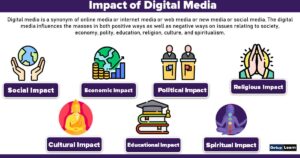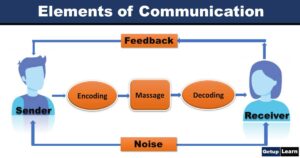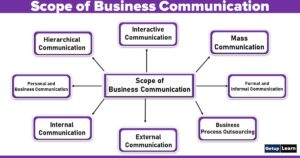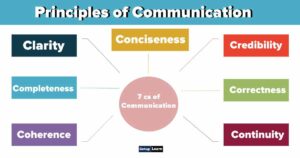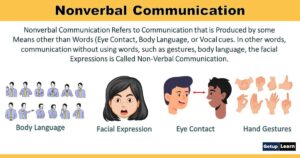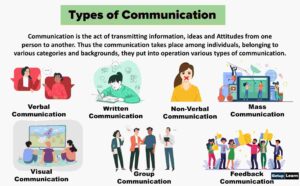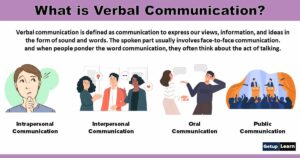Table of Contents
What is Mass Madia?
Mass media here means communication through a number of physical transmission modes such as print, audio, visual, audio-visual, and electronic forms to a general mass of common persons, irrespective of their position, intellectual attainments, or social status, etc.
Table of Contents
It is a means by which almost all current human affairs are collected, recorded, and disseminated for the consumption of any common person.
It is an instrument by which the general common public is kept informed of political activities of a state, international relations between countries, economic and business affairs, industrial relations, games and sports, cultural events and entertainments, and a host of other subjects.
Mass media is typically represented by printed daily newspapers, weekly, fortnightly monthly magazines; broadcasting over radio, telecasting over television, and a number of other combinations of audio and visual communications such as Audio Cassettes, Video Tapes, Compact Discs of recorded music.
This field has expanded very rapidly with the advances in information and communication technology. These have become very powerful tools in political, economic, business, cultural, and in every other human activity. Let us examine the well-established institutions of the mass media.
Types of Mass Media
Mass media can be classified according to their physical form, the technology involved, and the nature of the communication process. The general classification on this basis is as follows:
Traditional Media
Traditional media are the oldest of all other media and are connected with the folk art forms of society. Every country has its own unique folk art forms, as we have Theyyam, Padyani, Oppana, and Margam Kali in Kerala to express our cultural messages.
India is rich with folk art forms and the oral traditions of communication. Like other states in India, Kerala has a rich collection of folk art forms.
Examples are: Theyyam, Thira, Chavittu Nadakam, Pulluvanpattu, Thumbithullal, Kalampattu, Balikkalam, Kakkarassi Nadakam, Kalamezhuthu, Nagappattu, Oppana, Kolkali, Dufmuttu, Arabanamuttu, Mudiyettu, Margamkali, Gadhiga, Parichamuttu, Koithupattu are some of them.
Characteristics of Traditional Media
The following are the general features of traditional media. The nature of each medium may change depending on its type and cultural context:
- The stage for performance of traditional art forms is natural, known and friendly.
- The performers and the audience are known to each other.
- The contents are simple and familiar.
- Unlike other modern media, people never get tired of them.
- The performances are spontaneous and most often made on the spot.
- The performer can make changes in the content according to the level of the audience.
- The traditional arts and folk arts combine several art forms like dance, music, songs and theatre to attract audiences.
Print Media
Among the print media that carry contents of mass communication, the daily newspapers occupy the centre. Today’s newspapers bring out supplements almost every day relating to education, science and technology, business and industry, management, sports and games, cultural events, entertainment, and so on.
Besides these daily supplements, they also bring out Saturday and Sunday magazines. They also bring out special supplements on occasions that are nationally significant, for example, Independence Day, Republic Day Teachers Day, Martyrs Day, or important religious festivals.
Major forms of print media are:
Newspapers
As a mass medium, newspapers influence people in many significant ways. Capability to be used for future reference make newspapers favourite medium of the people. Diversity of content is another feature of this medium.
It can carry a rich mix of news, features, articles, columns, cartoons, graphics, editorial, etc. Readers can select what they want from the entire content.
Characteristics of Newspapers:
- Predominance of News-oriented Content.
- Regular Periodicity.
- Future Reference Facility.
- Choice of the Time of Use.
- The Literates’ Medium.
- Low Cost.
- Textual Medium.
- Multiple Users.
Magazines
Magazine is originally an Arabic word that means storehouse. In journalistic terms, magazine is a collection of materials like stories, poems, and other items. The Spectator published by Joseph Addison of England in 1711 is considered to be the first full-fledged magazine in English.
Usually they cover non-news items though there are news magazines too. Magazines contain a variety of topics like current affairs, business, women, children, finance, gadgets, photography, science and technology, education, career, health, luxury, life style, beauty, fashion, entertainment and travel.
Magazines are considered the mass medium that spread culture and nationalism.
Books
The Papyrus (from which the word paper is derived) rolls of the Chinese are considered the ancestors of modern books. The concept of books existed in China and in Babylonian way back in 3000 B.C. The Chinese used papyrus rolls made of bamboo strips while the Babylonians used clay tablets for writing.
In Rome, animal skins were used to prepare books. Though the introduction of paper popularized books, the absence of easy printing method blocked their mass production. Earlier books were hand written and were called manuscripts.
The printed books appeared in 868AD. The first book in India ‘ ‘The Spiritual Compendium of the Christian Life’ was printed in 1561 and the first one in Malayalam ‘Sampkshepa Vedartham’ in1772.
Electronic Media
The history of electronic media starts with the invention of cinematography by Lumiere Brothers who conducted the premiere show of cinema in 1895. Later radio was invented by Guglielmo Marconi. The first radio station was set up in Pittsburg, New York and Chicago in the 1920s.
Following this, the European countries also started radio stations for broadcasting news and entertainment content. The colonial powers like Britain and France set up radio stations in Asian and African countries in the early years of the 20th century.
Television broadcasting waThe invention of the Internet and the World Wide Web opened up several new avenues for mass communication which include e-mail, websites, podcasts, e-books, blogging, social networking sites, Internet Protocol Television, Internet radio and the like.
These kinds of online and digital means of producing, transmitting and receiving messages are called new media.s initiated in the US on an experimental basis during 1920s. But, the dramatic impact of television as a mass medium began only in 1950s. Parallel to these, recording industry also boomed in the western countries.
In short, the term electronic media mainly include:
Film
The Lumiere brothers made their first film La sortie des usines Lumiere (Workers Leaving the Lumiere Factory) using the camera patented by them in 1895 at the Eden Theatre in France. This minute-and-a-half-long movie depicted workers coming out of the factory during their lunch break.
They named their invention a Cinematographer. It is from this word we get the term ‘cinema’ for moving pictures. At first, it was the age of silent movies. The first feature film made on Indian soil is Raja Harischandra, directed by Dhundiraj Govind Phalke in 1913.
It was based on the story of King Harischandra. Vigatha Kumaran (The Lost Child) directed by J C Daniel, is the first film in Malayalam.
Radio
Radio broadcasting has been a major mode of mass communication. Akash Vani (All India Radio) has been offering this service from the beginning of this century in India without any competitors until the last quarter of a century.
Radio stations located at various regions in the country, broadcast news in English and other Indian languages, news analysis, entertainment programmes of various kinds, music programmes – both light and classical, suitable programmes for women, children, farmers, industrialists, educational programmes for schools and colleges and professional institutions. Sports and games get a good share of broadcasts.
Television
Television place in our daily lives today. It is a young mass medium, growing rapidly with the fast developing media technology to reach a very high level of sophistication in transmission. Satellite communication systems and multimedia have provided unlimited opportunities for telecasting a variety of programmes.
Television programmes range from entertainment to highly organised teleconferencing to project global news on a number of issues concerning political, social, economic and cultural affairs. A great number of persons with different qualifications and expertise are involved in television programmes. News, views, reviews, discussions, etc.
On current events and activities, instructional programmes for students at various levels, e.g., UGC programmes, programmes, live telecasting of national and international tournaments in sports and games, attract almost every human being irrespective or age, sex and occupation.
Characteristics of Electronic Media
Given below are some of the general features of electronic media:
- Radio is a medium for ears but television and films are for both ears and eyes.
- One needs to have some technical knowledge to use electronic media.
- The technology of these media is changing at a very fast pace due to frequent technological upgradations.
- The programmes in radio and television are available throughout the day.
- Radio, television and film are enjoyed by people with audiovisual disabilities and the illiterates.
- Satellite transmission makes electronic media programmes instantly available over a wide geographical area.
- Programmes in radio and television are ephemeral in nature.
- Live coverage is possible on radio and television.
New Media
The invention of the Internet and the World Wide Web opened up several new avenues for mass communication which include e-mail, websites, podcasts, e-books, blogging, social networking sites, Internet Protocol Television, Internet radio and the like.
These kinds of online and digital means of producing, transmitting and receiving messages are called new media.
We use search engines, like Google, to find information on the Internet. But social networking is a major facility available in new media format. Social networking is defined as a social structure connecting relationships between individuals or organizations.
A social networking site is an online platform where a user can create a profile and build a personal network that connects him or her to other users around the world. Social networking sites allow you to meet other Internet users directly. Facebook, Twitter, Linkedin and YouTube are some such sites.
Characteristics of New Media
The features of new media change rapidly in tune with the new developments in communication technology. Let’s discuss some fundamental characteristics of new media:
- The new media facilitate instant interaction between senders and receivers. Thus, this medium gives us the latest developments of events without any delay.
- If internet connectivity is available, one can access new media from any part of the globe.
- The new media contents are written in a hyper textual language, using hyperlinks. Thus, the users are gifted with large resources of data. For example, one can link to all sister publications of a newspaper from its home page. Multiple pagination facility enables websites to combine hundreds or thousands of web pages.
- As the content is stored in digital format, new media are highly technological and upgraded frequently.
- Above all, new media facilitate convergence of the various types of content like audio, video, text, image and data on a single device. This phenomenon is called as media convergence.
Media Convergence is the process where several media channels or formats come together to exist and operate in synergy in a single device. It is a merger of different mass media. The convergence of media is visible in everyone’s life.
For example, now we use mobile phones to talk to friends, listen to music, watch movies, send emails, surf the web, read newspapers, take photographs or videos and do more. Earlier we used separate devices like tape recorders, radio, newspapers, television, still cameras, and video cameras for these activities.
Functions of Mass Media
In a society like ours, mass media have a responsible role to play in fostering democracy, plurality and communal harmony through the functions listed below:
- Information and Education
- Socialization
- Entertainment
- Political Awareness
- Cultural Transmission
- Catalyst to Development

